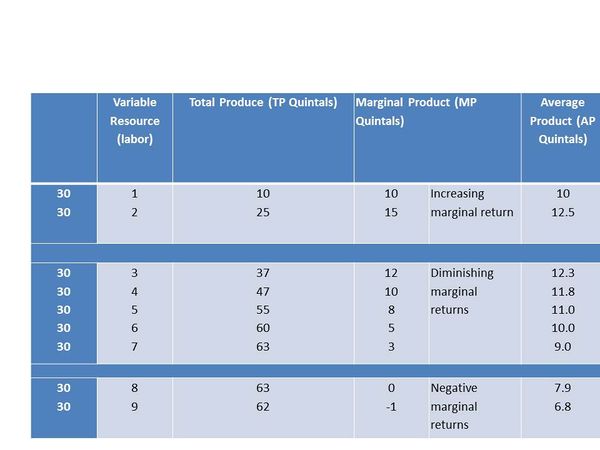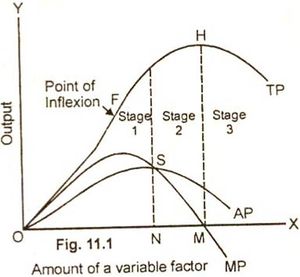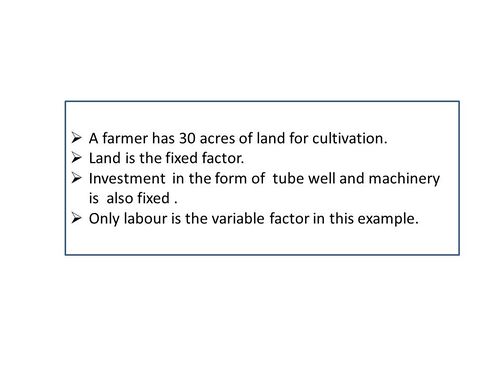Law of variable proportions
MICROECONOMICS

|
Law Of Variable Proportions |

|
Introduction |
Let us start the Law of Variable Propotions .
If you have your favourite ice-cream and start eating during a sunny day, first bite may bring you to knees while groaning “hai, hai, hai”.The next bite too brings good but different effect.By the time yu are halfway thorough gallon, you may be feeling totally different.With each chance, your stomach may become full, but mind has a new experience and the point of diminishing returns shifts. This what we are going to discuss here in the name of Law of Variable Propotions.
The law of variable proportion is the most important law in economics. Economists like Alfred Marshall, Benham,Samulson contributed maximium to this law.This law is based on short run production function.

|
Learning Objectives |
| After reading this chapter, you are expected to learn about: {{{3}}} | |
1. understand short run production Function.
2. Effect of continuous increase of variable factors on Fixed Factors and on output in the short run.
3 How this Law operates in each and every stage of life?
| Nature of the Law |
Let us start with the concept of a standard short run production function.
Q= f[L,[math]\bar{K}[/math], [math]\bar{T}[/math]]
Q→Output
f→ function of
L→Labour as the variable factor
→ Capital as the constant factor
→ constant technology.
| Definition of Law |
The Law of Variable Proportions which is the new name of the famous Law of Diminishing Returns.
→According to Stigler” "As equal increments of one input are added, the inputs of other productive services being held constant, beyond a certain point, the resulting increments of produce will decrease i.e., the marginal product will diminish".
→According to Paul Samulson "An increase in some inputs relative to other fixed inputs will in a given state of technology cause output to increase, but after a point, the extra output resulting from the same addition of extra inputs will become less".
The law of variable proportions states that as the quantity of one factor is increased, keeping the other factors fixed, the marginal product of that factor will eventually decline. This means that upto the use of a certain amount of variable factor, marginal product of the factor may increase and after a certain stage it starts diminishing. When the variable factor becomes relatively abundant, the marginal product may become negative.
Assumptions of Law.
→Constant technology--- This law assumes that technology does not change throughout the operation of the law.
→Fixed amount of some factors.—One factor of production has to be fixed for this law.
→ Possibility of varying factor proportions—This law assumes that variable factors can be --changed in the short run.
| KEY WORDS |
1,Total Product→ It is the total of output, resulting from efforts of all factors of production.
TP= P*Q
2Average Product→It is the total product per unit of the variable factor.
AP=TP/N
3.MarginalProduct→It is addition made to the Total Product as a result of production of one more unit of
output.
| Diagramatic Representation |
Following table explains the working of law.
Schedule:
Diagrammatic Representation of Law.
| Working of Law |
This law has THREE stages
1.Increasing Returns .
2. Diminishing Returns.
3. Negative Returns.
Increasing Returns:
In this stage, Average Product increases, Marginal Product increases and also Total Product. TP increases at more proportionate rate . TP increases from 10 to 25 units. This stage is known as increasing returns. This stage of increasing output by increasing labour does not last for a long time. This continues upto 3rdunits. The point F onwards TP increases at a diminishing rate. In the first stage, marginal product curve of a variable factor rises in a part and then falls. The average product curve rises throughout and remains below the MP curve. MP reaches maximum in this stage.
Diminishing Returns:
s This is the most important stage in the production function. In stage 2, the total production continues to increase at a diminishing rate until it reaches its maximum point where the 2nd stage ends. In this stage both the marginal product (MP) and average product of the variable factor are diminishing but are positive. When TP reaches the maximum, MP is zero.MP intersects the X axis in this stage.
As more and more variable factors are used on fixed factor, marginal and average product begins to decrease. Factors of production are indivisible. Economically this is the most viable area of production.
3.Negative Returns.
In the 3rd stage, the TP decreases. The TP, curve slopes downward (From point H onward). The MP curve falls to zero at point L2 and then is negative. When we increases the labour even after MP becomes zero, then MP becomes negative and it goes below the X axis.This is the most unviable region. In our table from 8th unit onwards, this stage starts.
Any sensible producer will stop the production in the second stage where AP and MP begins to decrease, but MP has not become negative.The producer will employ the variable factor (say labor) up to the point where the marginal product of the labor equals to the wage rate.
| ACtivity |
1.Imagine you are studying to take an easy test. Let’s assume that you can learn everything in about 10 hours of study. The first 10 hours of studying will have a much greater impact on your test score than your second 10 hours of studying. After a certain point, any extra studying will be a waste of time because you already knows the material.
2. Imagine now that you are going to clean your messy bedroom. The first hour of cleaning will make the most difference, the second hour should make less difference than the first hour, and eventually, if you continue cleaning your room, your extra time spent cleaning won’t make much difference at all because your room will already be clean.
| Recapitalisation |
→ This law is based on short production function.
→The gist of law is that if quantity of variable factors is increased keeping constant, other factors, eventually AP and MP will decline.
→ This law is applicable in all industries, but more In agriculture.
→ Rationale producer prefers second stage where TP reaches maximum, MP become zero, not negative. and AP decreases.
→ Third stage is unfeasible because MP is negative, so no meaning in paying additional wages to labours.
| Reference |
1. Stonier & Hague--Economics.
2. Samulson- Principles of Economics
3.H.L. Ahjuja- Principles of Economics





